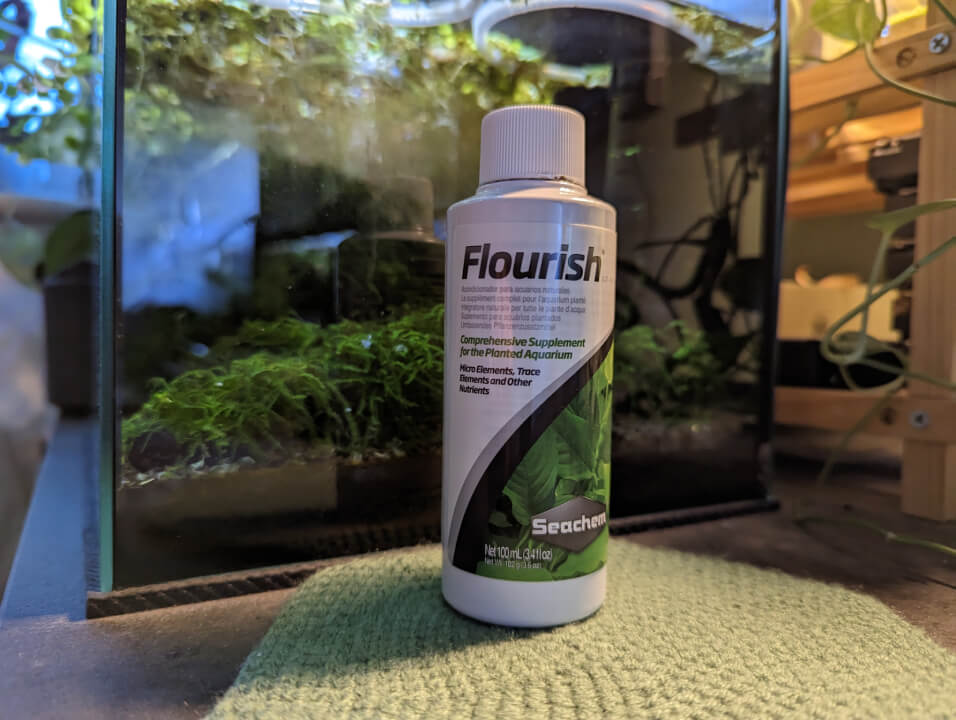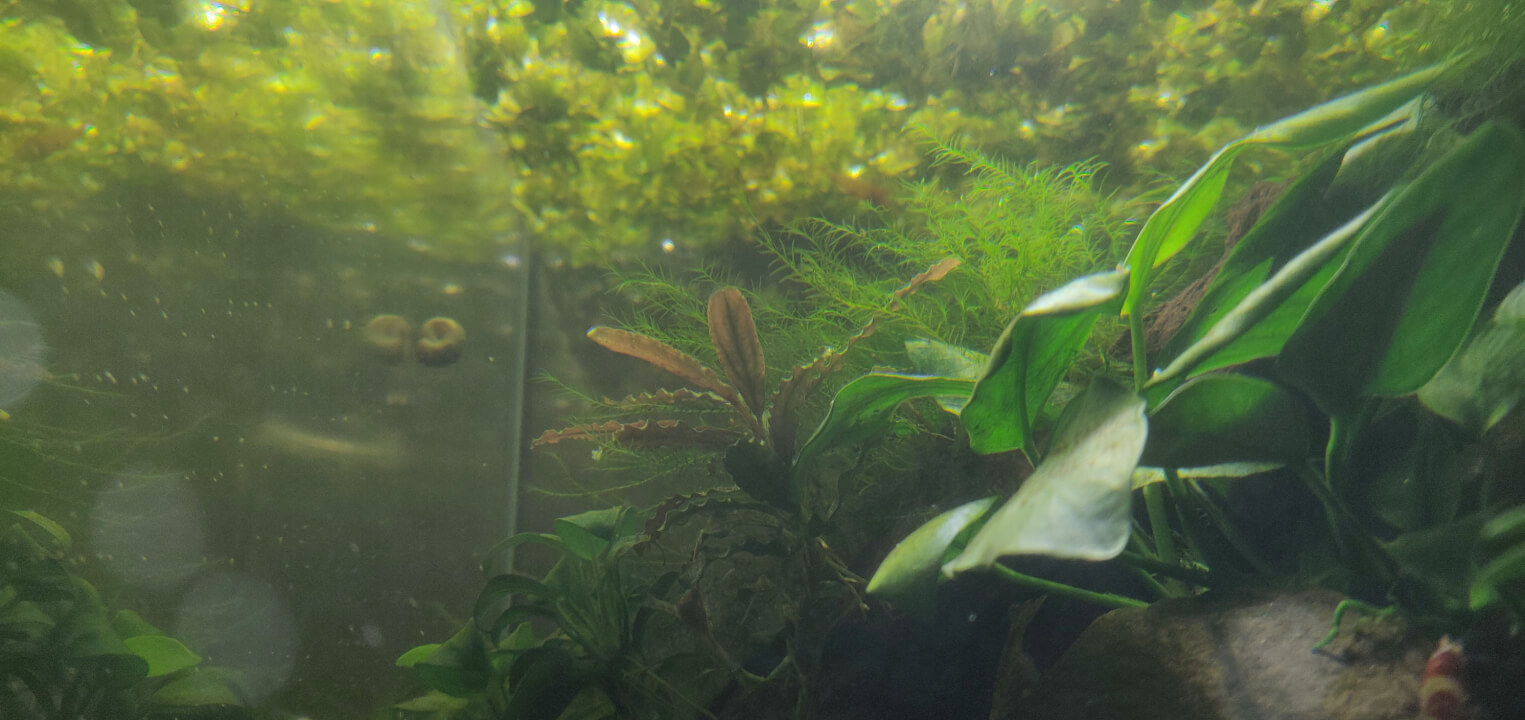Shrimp love plants. A heavily planted tank gives them plenty of hiding places, and surface area for biofilm and algae to grow.
Using fertilizers and a good light setup can boost your plant growth and boost all of these benefits for your shrimp.
However, you do need to be careful and make sure your fertilizer is safe for shrimp.
What makes fertilizers dangerous for shrimp?
In general, shrimp are pretty sensitive to changes in their water parameters.
Adding some chemicals can have an instant impact and shock the shrimp. This is why dosing correctly is so important.
One ingredient you’ll find in almost all fertilizers, copper, is also highly toxic to shrimp.
Copper and shrimp
Shrimp, like most invertebrates, have proteins called hemocyanins. These proteins have two copper atoms which bind to oxygen and carry it around the body, letting the shrimp breathe.
They perform the same role as red blood cells in humans and other mammals.
But if shrimp need copper in their body in order to live, what makes it so toxic for them?
Copper is a fairly rare element in their natural environments. They’ve evolved to quickly absorb the free copper they manage to find.
This overloads what their bodies are capable of handling, and can damage or kill their cells, possibly leading to death.
Copper and plants
Copper is also required by plants for strong and healthy growth.
It plays a part in the photosynthesis process, feeding the plant and producing oxygen.
It also helps the plant to produce something called lignin. This is a binder found in the cell walls, and essentially helps to keep the plant standing upright and strong.
Copper can help the plant to handle stressful conditions better too. A copper deficiency can increase the chances of disease.
Safe fertilizers

The fertilizers listed below are safe to use in your shrimp tank, as long as you follow the dosing instructions.
This list isn’t complete, other options may be safe to use too, but you should check their FAQs or search before using it with shrimp.
- Seachem Flourish
- NA Thrive S All-in-One Shrimp Specific Liquid Aquarium Plant Fertilizer
- 2Hr Aquarist APT Complete
Dosing tips
- Do half doses to start with
- Measure for your tank’s water volume
- Never do catch-up doses, a double dose could be lethal
- Try to add into moving water to spread it evenly
- Use a syringe to measure accurately
- Be consistent
Start with half doses
Especially when starting with a new fertilizer for the first time, it can be a good idea to only dose with half of what the instructions recommend.
This gives you some more time to monitor your shrimps’ behaviour, and you can get the confidence it’s right for your tank.
After a couple of weeks or so, you can then increase the dosage to the recommended level.
Measure your tank’s water volume
You know the size your tank was advertised as, but that’s not necessarily how much water is in it now.
If you’ve got a lot of substrate, rocks, and driftwood, this will all be taking up some of the tank’s volume.
Just for example, imagine you’ve got a 5 gallon setup, but your hardscape took up 2 gallons of space. If you then dose for 5 gallons of water, instead of the 3 gallons you actually have, you’d be dosing almost double the recommended amount.
Never do a catch-up dose
Sometimes we can forget to dose the fertilizer, or we aren’t at home for a few days.
You should never try to catch back up to your schedule, always keep under the level in the instructions. Overdosing can be lethal for your tanks.
For example, adding 1ml of your fertilizer each week might be fine. If you’re going away for 2 weeks, do not dose with 2ml before you go or when you get back. Instead, you should just return to your normal 1ml/week as soon as you can.
Spread it around the tank
Try to pour the fertilizer liquid into flowing water, if you can.
If you’ve got a Hang on Back filter, adding it just under the waterfall will help it to quickly spread all around the tank.
Pouring into a corner with little water movement can make that area slightly more dangerous for your shrimp until it disperses.
You should also avoid adding the fertilizer near your shrimp. Give it time to dilute, instead of showering them in chemicals.
Use a syringe
Quite often the instructions will give you measurements in capfuls.
This can work well in larger aquariums, but in smaller shrimp tanks this can cause really inaccurate dosing.
Using a small syringe, up to say 5ml or so will make dosing much less stressful. You can measure exactly the correct amount, and be confident you won’t stress or harm your colony.
I use a blunt needle tip, advertised for using with printer ink, for dosing my tanks. It lets me easily reach the bottom of the bottle, and I can inject the fertilizer deep into the water.
Be consistent
Do water changes and dosing on a regular schedule.
Shrimp love consistency, keeping a fairly constant level of plant food will cause them minimal stress and let them thrive.
Over time, the ingredients of the fertilizer will get used up at different rates.
With irregular or infrequent water changes, this can lead to chemicals or metals building up to a dangerous level.
Dealing with overdosing
Whether you’ve accidentally dosed again, or misread the instructions and added too much, these steps should help.
- Perform a water change
- Add activated charcoal to your filter
- Add Seachem Cuprisorb
- Temporarily rehome your shrimp if it’s really bad
Do a water change
The easiest first step is to do a relatively large water change.
Don’t go crazy and replace 50% of the water in one go just yet. This will cause extra stress on your shrimp and could do more damage than overdosed fertilizer.
Use activated charcoal
Activated charcoal is fantastic at absorbing elements from the water.
If you can put a bag of it near your filter, you should be able to pull most of the unwanted elements fairly quickly.
Do note that charcoal doesn’t care what it absorbs, it’ll collect dangerous and helpful elements alike.
Dosing a tank with activated charcoal in the tank will mean that some of it gets wasted, as the charcoal collects some of it before the plants get a chance.
Add Cuprisorb
Cuprisorb is a product by Seachem, made specifically for quickly absorbing copper and other heavy metals out of the water.
They claim this works faster than activated charcoal, so it could be useful to have around in an emergency.
Rehome your shrimp
In a worst case scenario where your water is suddenly toxic for its inhabitants, your only option might be to rehome them temporarily.
Try to net your shrimp into a new container or tank, and acclimate them to their new water, just like you would if they were newly bought.
This gives you more time and freedom to deal with the problem in their old tank. You could even do a 100% water change whilst there aren’t any shrimp in it, for example.

